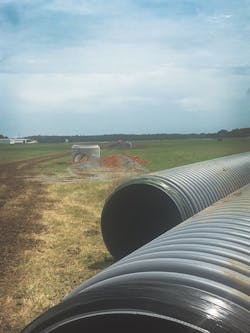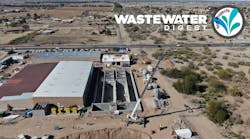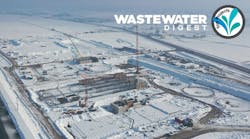Cost: $1,080,000
Location: Tuscaloosa, Ala.
Year: 2018-12-01
Size: 3,700 ft of pipe
Owner: Tuscaloosa Regional Airport
Designers: Aviation Services - Atkins
Contractor: REV Construction
When sinkholes began to develop along the outer edge of the safety area for the main runway at the Tuscaloosa (Ala.) Regional Airport, the city took action to save the airport, prevent damage to aircraft and protect the field maintenance crew by replacing the storm water drainage system.
To stop future sinkholes due to infiltration of water into the system’s concrete pipe, stakeholders decided to use polypropylene pipe that has high-integrity gasketed joints between sections.
The Tuscaloosa Regional Airport has fixed-based operator centers serving some 60,000 charter, cargo, military, and private aircraft operations each year.
A portion of the airport’s storm drainage infrastructure dates to the late 1960s when the concrete pipe and joints along with the brick masonry inlet structures started showing signs of failure. Video inspection inside the lines showed that sediment was infiltrating through the separation of some of the pipe joints and through failed mortar joints in the brick inlet structures along with the connection points from pipe to inlet structures. These failures, and the resulting sinkholes, provided the justification to rehabilitate the storm drainage system with watertight connections. REV Construction decided to replace these pipe runs with a corrugated polypropylene pipe.
Installation of the new pipes was divided between two storm drainage collection systems between the runway and taxiway. The $1.08-million construction portion of the project was completed in Sep. 2017 after just 116 work days.
“The major elements of the work included 6,454 linear ft of storm drainage pipe that needed to be rehabilitated or replaced,” said C. Darren Duckworth, P.E., project manager, aviation services for Atkins. “There were also 15 brick inlet structures that would be replaced with new precast concrete inlet structures along with installation of two replacement headwalls and grading of 372 linear ft of ditch channel.”
According to Duckworth, the existing pipe running under runways was rehabilitated with cured-in-place pipe (CIPP) so they would not have to dig up any of the pavement. Three thousand eight hundred linear ft of pipe was removed and replaced with new pipe.
“These pipes run under grassy areas that are not subject to traffic loading and lie outside of the Runway Safety Area limits and any Taxiway Object Free Area limits,” Duckworth said. “Bid options allowed for either removal and replacement with new pipe or rehab with CIPP linings, and the project specifications allowed for multiple options in the material to be used for pipe replacements. The successful bid from REV Construction elected to replace these pipe runs with a corrugated polypropylene pipe in accordance with [Federal Aviation Administration] specification D-701.”
The majority of the pipe was dual-wall pipe with a smooth inner wall and a corrugated outer wall. A double gasket connection was made from the main run of dual-walled HP Storm pipes to a section of triple walled SaniTite HP pipe. The pipe has a smooth exterior, which permits a stronger seal for the compression gasket at the inlet structure than would have been possible with corrugated double-wall pipe exterior.
“The more usual practice in storm drain installations is to provide oversized openings in the precast structure and to subsequently complete the installation with an annular ring of non-shrink grout to fill the remaining void,” Duckworth said. “Grouted connections were specifically avoided to prevent the risk that any flexure or settlement of pipes might cause a grout failure that could ultimately create a potential point where sediment might be driven into the system with groundwater.”
The contractor’s team worked through the material submittal process with Advanced Drainage Systems Inc. (ADS), the precast inlet structure supplier and the design team to develop a solution that would work. They elected to use prefabricated compression gaskets of suitable size and performance range to match the outside diameter of the triple-wall polypropylene pipe at each inlet structure. These were supplied to the precast structure manufacturer and precast into concrete inlet structures.
ADS HP Storm and SaniTite HP pipe are high-performance polypropylene pipes for gravity-flow drainage applications. They use advanced polypropylene resin technology with a dual-wall and triple-wall profile design for performance and durability.
“In addition to the pipe joints having double gaskets to guard against potential soil intrusion, there are fewer joints in a corrugated polypropylene pipe line because of the 20-ft-long sections,” said Tori Durliat, director of marketing for ADS. “The old concrete pipes had a joint every 4 ft in addition to providing fewer locations for a potential joint failure. The longer HP Storm pipe section length and lighter weight also allowed the installation to proceed more quickly. Most of the work was completed well in advance of the 140-day time limit specified in the contract.
Click here to read more about the 2018 iWWD Top Projects.
Project Year: 2018-12-01Contractor: REV ConstructionDesigners: Aviation Services - AtkinsOwner: Tuscaloosa Regional AirportLocation: Tuscaloosa, Ala. Cost: $1,080,000Size: 3,700 ft of pipe


